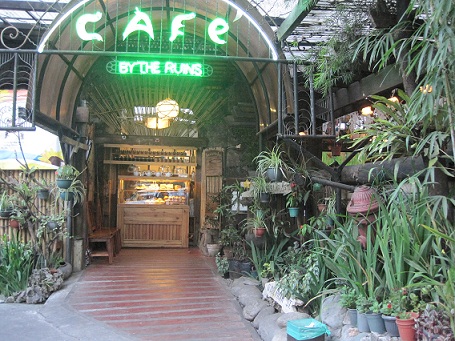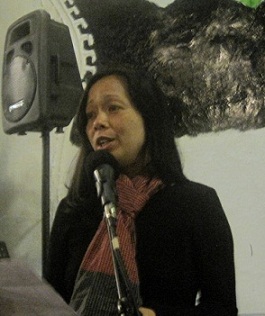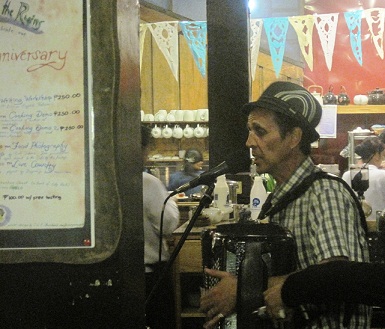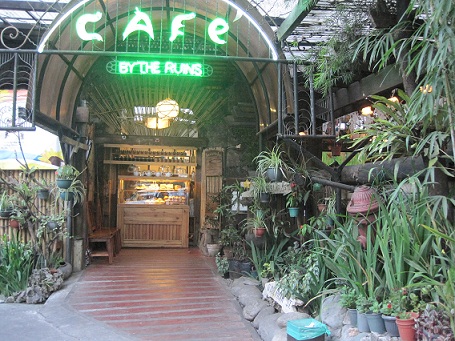Text and photos by ELIZABETH LOLARGA
 IT is apropos that a café founded by artists, writers and other individuals who operate outside society’s margins should mark its 25th year as a now respected Baguio institution with music, poetry and a satirical monologue aimed at the foibles of the city’s bigwigs.
IT is apropos that a café founded by artists, writers and other individuals who operate outside society’s margins should mark its 25th year as a now respected Baguio institution with music, poetry and a satirical monologue aimed at the foibles of the city’s bigwigs.
Capping a week of workshops on food writing, demonstrations and photography, “Silver Spoons and Tunes,” the program prepared by Café by the Ruins, showcased Baguio’s wordsmiths and musicians. It testified to the café’s support of the arts and literature, apart from espousing the slow-food movement and basing its “lunch of the day” on what is available and fresh at the public market.
One of the café partners, Baboo Mondoñedo, once wrote, “When Café by the Ruins opened in 1988, the artists found a home. At the cafe they planned, plotted, exhibited and even put up their installations. Other people helped them get their act together, among them Su Llamado and Rudi Tabora. The cafe became the setting for cañao performed by the mambunong, and people dancing to the rhythm of the drums and the gongs…On this launching pad, the Baguio artists’ cause and works gained national attention and support. With the artists’ community coming alive, the city found its soul.”
Anthropologist Padma Perez, who practically grew up at the café, recalled how the café’s food reflected what was cooked and served at home. Her need to belong made her yearn for fried Spam or hotdogs in Tupperware containers or juice made from instant powder mix, the staple baon of her grade school classmates. Instead, what she brought was something slow-cooked by her mother Adelaida Lim, a café partner who contributed heavily to the café’s near-iconic menu, and packaged in a tampipi (native basket) to the child’s mortal embarrassment.
 Today, Perez realizes the ecological soundness of it all. The café still doesn’t serve soft drinks and liquor but has a fine wine list and fruit sodas inspired by the seasons (strawberry, tamarind, guava).
Today, Perez realizes the ecological soundness of it all. The café still doesn’t serve soft drinks and liquor but has a fine wine list and fruit sodas inspired by the seasons (strawberry, tamarind, guava).
The other readers like Merci Javier Dulawan recalled her wedding and honeymoon and how she was initiated into drinking the heady native tapuy or rice wine that loosened her tongue. It has become a joke among friends how she forgot to take off her shoes when she climbed onto her marriage bed.
Actor Karlo Altomonte spoke of how the city’s fog, gardens, trees, small cafes and bars have played romantic setting to his own love story. He and his wife have also used Baguio’s overdevelopment (clusters of high-rises and flyovers that have marred the skyline) as material for plays and documentary films. He also noted contradictions in the streets (e.g., rows of bars across from an elementary school, police cars that pass through red lights, etc.).
All these indicate how once fair-haired and idyllic Baguio had become, in poet Desiree Caluza’s words, the scene of “wild thoughts and wild screams.”
In his spoof of the café and its founding partners, actor-director Martin Masadao, playing the role of vacationing socialite Doña Margarita Kahlua Josefa Cuervo vda. Cerveza, poked fun at how the site went through 16 renovations (“that’s like having a renovation every time Bencab had a new girlfriend”). After all, the architecture made do with what was left of the walls and foundation of the former house of American Gov. H. Phelps Whitmarsh.
Masadao, speaking through barb-tongued Doña Margarita (a slim version of Doña Buding), also had a hilarious aside or two about the artisanal food the café pays homage to, particularly the flavorful, aged Cordillera etag (cured meat).
He said, “The very same etag they used in 1988 they still use today for their pinikpikan! Apparently, after they cook the broth, they take out the etag and bury it in the ground again. Kaya masarap ang pinikpikan nila dito! Hindi lang artisanal, vintage pa!”
 In the spirit of fun, Doña Margarita spoke of her first visit on a rainy day to the café where she was aghast to find no valet to meet her, to see batibot chairs that she considered low-class. She was charmed by a child, Padma, who handed her a complimentary tea steeped in hibiscus. “Teka, hibiscus?” the older woman asked. “Di ba gumamela lang yan? Masyado namang conceptual ang tea na ito. Palibhasa mga flower power ang mga may-ari!”
In the spirit of fun, Doña Margarita spoke of her first visit on a rainy day to the café where she was aghast to find no valet to meet her, to see batibot chairs that she considered low-class. She was charmed by a child, Padma, who handed her a complimentary tea steeped in hibiscus. “Teka, hibiscus?” the older woman asked. “Di ba gumamela lang yan? Masyado namang conceptual ang tea na ito. Palibhasa mga flower power ang mga may-ari!”
Masadao acknowledged the café on Chuntug Street for evolving unlike the City Hall across from it where “you still have the same people sitting.”
Five years ago, the café owners already left a more or less permanent legacy, Café by the Ruins: Memories and Recipes (Anvil Publishing) written by second-generation managers Feliz Perez and Lia Llamado with Lim’s recipes. The food is simple to replicate but not the café’s spirit of a “guerilla cultural center.”
